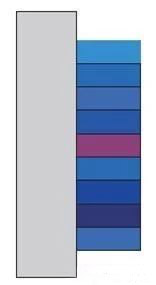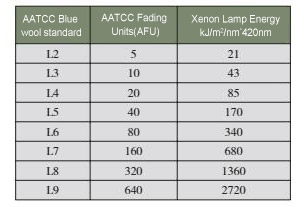Among the textile testing equipment, the insolation color fastness tester is relatively conventional, and it is also one of the most concerned of color fastness testing. This testing project is not difficult, but in the practical process, often encountered a variety of problems. Here we will analysis the common problems about national standard, ISO and AATCC color fastness test standard, for your reference.
1.What is the difference between blue wool sample 1-8 and L2-L9? Are they interchangeable?
In GB/T 8427 and ISO 105 B02 standard, the blue wool samples 1-8 and L2-L9 have described in detail. They are all made of wool with 8 grades of blue label,The light fastness of each blue label is approximately twice that of the previous one. But they use different dyes and processes.
Blue label 1-8 is dyed with eight dyes with different light fastness. Applicable to European exposure conditions specified in GB/T8427 and ISO105 B02 standard. L2-L9 is a kind of raw fiber dyed with two dyes, and the dyed two fibers are made into L2-L9 in different proportions. Applicable to us exposure conditions specified in GB/T8427 and ISO 105 B02 standard. And it is applicable to AATCC TM 16 standard. Therefore, blue label 1-8 and L2-L9 cannot be mixed, and the test results cannot be exchanged.
2.The light color fastness tester has the relative humidity in the chamber, why is it necessary to calibrate the humidity control standard sample?
At present, most of the light color fastness tester can display the relative humidity in the chamber. However, in GB/T 8427 and ISO 105 B02 standard, the humidity in the cabinet is calibrated daily using the humidity control standard. The reason is that the relative humidity in the chamber is not the "relative humidity", but the "effective humidity". Effective humidity is also called the absolute humidity. It is combining the air temperature, the surface temperature of the sample and the relative humidity of the air that determines the moisture content of the sample surface during the exposure process. "Effective humidity" directly affects the light fastness test results of humidity sensitive samples. So GB and ISO standards stipulate that the humidity in the chamber should be checked every day.
The humidity control sample is cotton fabric dyed with red azo dye. The use method is as follows:
A.Taking A piece of humidity control cloth(no less than 45×10mm) and blue wool standard sample be mounted on a cardboard and placed in the middle of the sample clip as far as possible.

B. Expose partially covered humidity control samples and blue wool samples at the same time until the color difference between the exposed and unexposed parts of the humidity control samples reaches level four.
C. At this time, the standard blue wool sample is used to evaluate the color difference between the humidity control cloth and the standard blue wool sample of which grade. For example, under the general condition of European standard insolation conditions, the color difference between the insolation and non-insolation parts of the standard humidity control sample is consistent with the color difference of the blue wool cloth of grade five. Recalibrate the controller instrument to maintain the specified blackboard temperature and humidity if necessary.
3.What is the role of AATCC TM16 Xenon Reference Fabric is?
The Xenon Reference Fabric is a purple polyester fabric whose function is to determine if the temperature inside the box is correct. The method is as follows: placing the Xenon reference fabric on the sample holder for 20±2h, if the discoloration of the reference fabric is consistent with the Xenon reference standard or using the instrument color measurement to obtain a color difference of 20±1.7 CIELAB, and certificate the chamber temperature is normal.
4.In some standards, some of the light fastness tester of need to do the method 3, and the quality requirements are intermediate levels, such as 3-4, how to do the testing?
Some product standards do have such requirements, and some experts say that this formulation is completely wrong, because the experimenter can not choose the blue wool standard. However, since some current product standards are currently stipulated in this way, it is recommended for the operator to use Method 3 for experiments, and then refer to Method 1 for rating. For example, the standard requirement is 3-4. We will select the required test specified in Method 3 of the fourth and third grade blue wool standards. For the rating, please refer to the rating method of Method 1, because there are 4th and 3rd grade blue wool. In the standard, we can judge whether the test results of the sample reach 3-4 grade theoretically.
5. What is the unit of AFU in the US AATCC standard? What is the relationship with the number of hours?
AFU is an energy unit, which is the abbreviation of AATCC FADINGUNIT, which is defined as: 1/20 of the required exposure energy when the L4 blue wool standard is faded to the color gray card level four. In other words, it takes 20 AFU of energy to make the L4 blue wool standard fading to reach level four color change. The AFU and radiant energy values for the L2-L9 blue wool to achieve grade 4 color change are shown in the form below.

The relationship between AFU and hours can be calculated by a formula. It is assumed that when the lamp is only operated under 1.10w /m2• nm, the energy of L4 reaching grade 4 color change is 85 kJ/m2.
85 kJ/m2=" 1.10w /m2x3.6x (hours)
Hours = (85 kJ/m2)/(1.10W/m2x3.6) =21.5
It can be seen that when the radiant energy of xenon lamp changes, the number of hours will also change when it reaches the prescribed AFU in the west of the day. When the lamp operates only under the condition of 1.10 W/m2• nm, the energy of 20 AFU can be reached in 21.5 hours.
Recommend the Light fastness tester of GESTER instrument co., LTD.: